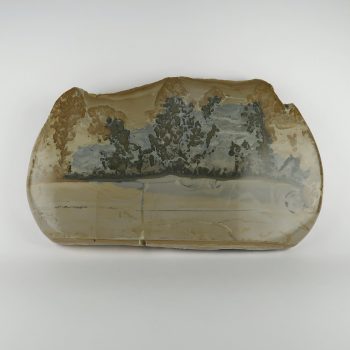Cotham Marble
Cotham Marble is a stromatolitic Limestone from the area around Bristol and south Wales.
When cut and polished, the stone shows patterns which almost look like a countryside view, with fields, hedges, and trees – not something you’d expect to find naturally occurring in a stone!
It is too soft for external use, and is usually made into decorative objects or sold as a polished slice for collectors – although some people do make jewellery from smaller cut pieces.
Showing all 2 results
There are two names for this material – ‘Cotham Marble’ and ‘Landscape Marble’. These names are inaccurate, though – the stone is a stromatolitic limestone, not a marble.
Appearance
In its rough form, ‘Cotham Marble’ is a bumpy, almost botryoidal ‘lump’.
It is when the stone is polished it becomes interesting – a polished face shows an image that looks almost like a landscape, with fields, trees, hedges and bushes.
If you saw the material without knowing anything about it, you’d be hard pressed to believe it was natural, but it formed around 200 million years ago.
Uses and History
Cotham Marble is primarily used as a decorative stone. It is pretty much exclusively sold polished.
This material has been used to produce decorative ornaments, inlay, and display pieces – as well as jewellery, in some cases.
It has been used for some decorative wallmountings, too, but is too soft for long term external use.
Locales
This material occurs within the Cotham Member formation, which runs between Glamorgan to southeast Devon.
Currently, this is the only known locale.
Mineralogy
This material ought to be easy enough to distinguish by eye when polished – if it is unpolished, the locale may be a key indicator.
It may be possible to test with an acid, as Calcium and Limestones can both react readily with acids.
Hazards and Warnings
Limestone is partially soluble in weak acids.
Almost all rocks, minerals (and, frankly, almost all other substances on earth) can produce toxic dust when cutting, which can cause serious respiratory conditions including silicosis.
When cutting or polishing rocks, minerals, shells, etc, all work should be done wet to minimise the dust, and a suitable respirator or extraction system should be used.


